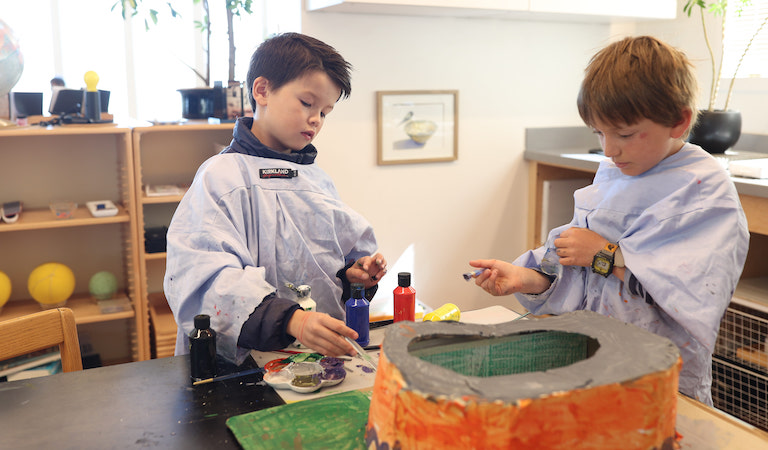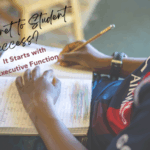In the last couple of months, I’ve been able to connect with a number of my own past students and graduates of Marin Montessori School. During these conversations, one of the things that has struck me is that they consistently tell me stories about their pursuits in which it is clear that they are wringing every ounce of experience out of their lives.
I have heard from an entrepreneur who started a business after college, a dancer, a surfboard designer, an actor, a wilderness guide, a marketing student, an attorney, and a music producer. They are creators. They are problem solvers. And, they are thriving.
In order to develop these kinds of creative thinking chops, children need regular and robust opportunities to think for themselves. They need to practice thinking and creating.
It’s a significant loss that children are now growing up in an environment that seems to value them primarily as consumers rather than creators. The data and anecdotal evidence alike paint a picture of a generation that spends an inordinate amount of time online consuming the creations of others – or mimicking those creations in the social media feedback loop.
In a 2019 Pew Research report, researchers note that,
Nearly all U.S. teens (95%) say they have access to a smartphone – and 45% say they are “almost constantly” on the internet. That amount of screen time has raised concerns from parents, educators, and policymakers across the country, and even many teens worry they use their phone too much.
If we want to interrupt this phenomenon, the Montessori approach has some wisdom that parents and educators can use to grow active creative thinkers.
Building Blocks for Creativity
While some humans come into the world with innate skills and talents that serve their creative pursuits, Montessori principles can increase the likelihood that all children have the time and tools to deepen their talents, sharpen their vision, and follow their curiosity to think creatively.
Among the building blocks:
Foundation of Skills
Children are offered the opportunity to develop the control of movement needed to be able to carry out any idea that they can imagine. Via practical life activities and work with materials, they develop a foundation of skills that will allow them to pursue any projects they can dream up.
Foundation of Experience
Children have hours and hours of experience seeing, feeling, holding, and comparing objects that are designed to help them understand the world and abstract concepts. Via this work with the materials, the children develop an understanding of how things work and how they fit together. Through these acts, they internalize a collection of images that they can refer to when they are presented with new information or new scenarios in the future.
Freedom to Choose
Offering children the opportunity to grow up in a system that allows them to choose what they are going to do for their work, and what their follow-up to any lesson is going to look like, gives them the sense that anything they think of is valid. There are checks built in to ensure that their work leads to learning. But, by validating their choices, we remind them over and over that their creative thoughts are welcome. After all, creative thinking is an act of courage, and, this approach helps students to develop that courage.
Friendliness with Error
We welcome, in fact, expect, mistakes from our students. The materials themselves often alert them to their mistakes and guide them toward figuring out what went wrong. We call this control of error, which is a built-in feature of the Montessori materials.
Our students are also prepared to attend to any spills, bumps, or missteps they take while moving through our environments. When these mistakes happen, the students take care of them, and if additional help is needed, we step in to offer only what they need, ensuring that our message to the children is always, “We know you are capable. You can do this.”
Ensuring that our students are comfortable making mistakes also helps them to have the courage to commit to their creative pursuits knowing that if problems arise, they will be able to find solutions.
Opportunity to Make Every Work Something You Love
Because the children are offered the opportunity to choose their follow-up work, they can find ways to make every work include something that they love. If math is challenging, but they love drawing, they can decorate their math work. If writing is challenging, but they love math, they can calculate the percentages of adjectives in their paragraphs, etc.
Collaboration
When working with others, the children are exposed regularly to other people’s ideas. For instance, as they are thinking about what they might want to do for a project, they also hear from peers about their ideas. Then, they have to figure out whose ideas they will use and how they will incorporate them into the work. This repeated process gives them exposure to different ideas and access to more creative thinking. It also gives opportunities to bring these different ideas together into one finished product, which requires a whole additional set of creative thinking skills.
Independent Problem-Solving
Because our students choose what topics they work on, how they plan to explore those topics, with whom they will work, and how they will work together, they are constantly problem-solving when things go wrong with this work. For every piece of work they do, they are building their creative problem-solving skills at a rate that can not be matched. They are getting their 10,000 hours because thinking for themselves is a design feature of the Montessori experience.
Time
Our children really do need time in their schedules to reflect and think about their work and their ideas. When we schedule all of their time for them, one of the things they lose is the knowledge that they have time to think through their creative ideas. This is often enough of an obstacle to stop creative thinking in its tracks. This is one of the reasons we protect so dearly the three-hour uninterrupted work period in our classes.
During the course of a Montessori education, from toddler through teen, students gain the skills they need to bring their ideas into being while learning how to make good choices, how to persevere through challenging moments, how to find joy in all of their pursuits, how to work together meaningfully, and how to solve problems big and small.
They engage in their learning in the classroom and in the world because Montessori fosters engagement rather than entertainment. It fosters creative thinking and action rather than passive learning.

As the Director of Education for Elementary and career-long Montessori educator, Minnie relishes the gift that a Montessori education offers to children, families, and society.





